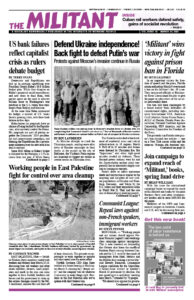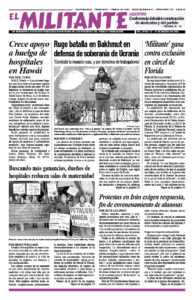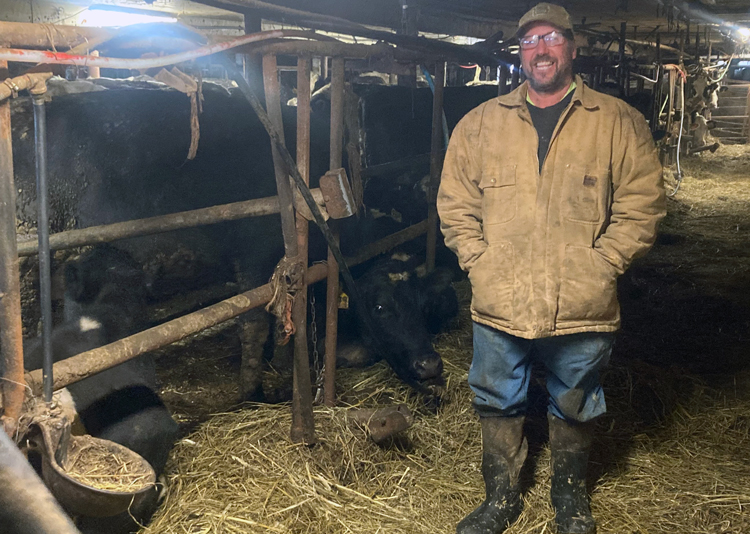BRIDPORT, Vt. — “There were 42 dairy farms in this area in the 1980s,” 11th-generation dairy farmer Paul Plouffe told these two Militant worker-correspondents when we visited his farm here Feb. 5. “Now there are just eight left, after a small organic farmer went bankrupt last year.”
“I could sell my farm for more than a million,” Plouffe said. “But I’m not interested. And my sons want to keep farming.”
Plouffe is one of a dozen North American farmers who signed a letter to the National Association of Small Farmers of Cuba (ANAP) last May, sending solidarity on the 61st anniversary of the organization’s founding and the 63rd anniversary of the First Agrarian Reform carried out by the Cuban Revolution.
The agrarian reforms in Cuba nationalized the land, preventing farmers from losing their farms because they had a bad year or couldn’t pay off loans. They could bequeath the farm to their children to keep farming, but couldn’t sell it.
Small dairy farmers across the United States have been squeezed by years of low prices for their milk imposed by the large milk processors, prices that didn’t cover the rising cost of production or the increasing prices demanded by feed, fertilizer and input monopolies. They also face rising loan interest rates combined with bureaucratic government regulation. In 2010 there were 1,015 dairy farms in Vermont, today there are 664.
“The big guys get all kinds of advantages,” Plouffe noted, referring to the big capitalist farmers. They get tax breaks, subsidies to buy machinery to capture methane from their cows or for installing solar panels, along with other government programs that aren’t available to the smaller family farms.
Plouffe raises about 90 dairy cows and grows corn and hay on his 400 acres of land. Unlike most dairy farmers, Plouffe owns most of his land outright, having inherited it from his father, who passed away last year.
“We’re fortunate, we don’t owe anything on our land,” he said. But that doesn’t mean he’s debt free. “We have rolling credit from the banks for things like feed, cattle, machinery.
“About seven years ago, I had to take out a $100,000 loan to buy feed. I’m still paying it off,” he added. Last year he didn’t use any fertilizer on his corn, because it was too expensive and he didn’t want to take on more debt.
Recent economic shifts mean farmers have been able to command a higher price for the milk they produce, “so we’re doing OK,” Plouffe said. But he knows he can’t count on that continuing. His wife, Becky Plouffe, works at a store in town. “It’s really her income that’s subsidizing the farm.”
‘That’s capitalist!’
“I lost half my cows several years ago,” Plouffe recalls, “because the feed company mixed in the wrong minerals and poisoned them.
“The feed company wouldn’t even say they were sorry,” Plouffe said. “Instead, they put a retainer on all the lawyers in this area to keep me from getting a good one. Tell me that isn’t capitalist!”
Plouffe went to court, “but the vet wouldn’t back me up. He works for all the big companies. If I had been a big farmer, they would’ve all kissed my ass.”
The big capitalist farmers are always looking to expand their operations, to swallow up neighboring farms, Plouffe notes. “It’s like a big rolling snowball to push the little guy out.” This allows them to get rid of competitors and maximize their profits.
Farmers sell their milk to dairy “cooperatives,” which in reality are just big capitalist milk-processing companies. If a farmer produces less than the assigned quota, he gets fined. But if he produces more than the quota, he’s not guaranteed he’ll get paid the full price for the extra milk. And there’s all kinds of extra fees imposed on farmers.
“We have to pay them for trucking our milk to their processing plant,” Plouffe said. “They recently jacked up that charge, saying they were paying the truckers more. But we don’t know if the drivers who pick up the milk are really getting paid more.”
Plouffe had followed protests by truckers in Canada last year. “Farmers in Quebec blocked the roads to support the truckers. They were united and they do stuff,” he said. “We haven’t done anything like that here.”
Even with all the dairy farmers who have been driven off the land, “we still have more weight than you think,” he said. “Put us all together and we’re at least equal to the big guys.”
‘If small farmers got together’
“You can imagine if all the small farmers got together we could park our trucks in front of the processing plants and keep any milk from coming in or out. Then we’d get some action.”
We told Plouffe that the Socialist Workers Party explains that we need an alliance of workers and farmers. Workers are wage slaves, farmers are debt slaves.
“We need each other,” Plouffe said. “Factory workers make the things we use to grow the food they need. We’re like spokes on a wheel. We need every spoke for the wheel to go around.”
Plouffe doesn’t think it makes much difference who is in the White House. “The president doesn’t really make the decisions, it’s the special interests,” he said. “Donald Trump said a lot of stuff, but he didn’t deliver.”
Both the Democrats and Republicans defend the interests of the capitalist class, we said. That’s why we think workers need our own party, a labor party based on the unions, that would fight for the interests of all working people all year round.


